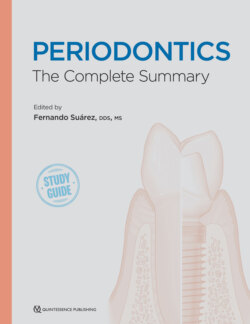Читать книгу Periodontics - Fernando Suarez - Страница 28
ATTACHED GINGIVA AND KERATINIZED GINGIVA
ОглавлениеThe amount of AG and the width of KG are also important clinical parameters to record during a comprehensive periodontal evaluation. AG extends from the free gingival marginal groove to the mucogingival junction (MGJ), and it is the portion of the gingiva bonded to the tooth and the alveolar bone through gingival fibers1 (Fig 2-2). On the other hand, KG includes free (marginal) gingiva and the AG. Around teeth, healthy and uninflamed gingival tissue usually encompass a band of AG, which is crucial to defend against pathogens.2
Fig 2-2 Gingival landmarks.
Lang and Löe performed a clinical study evaluating the inflammation status by examining gingival exudate of teeth with or without 2 mm of KG.16 The results from this investigation indicated that most teeth with < 2 mm of KG presented with clinical inflammation and varying amounts of exudate while surfaces with ≥ 2 mm of KG were healthy, and most of these surfaces showed no exudate.16 Therefore, it was concluded that 2 mm of KG and 1 mm of AG are needed to maintain periodontal stability.16 Nevertheless, evidence from another study demonstrated that when good plaque control is achieved through adequate home care, the presence of AG/KG is not an essential prerequisite for the maintenance of periodontal health and attachment.17 Overall, it is generally accepted that the presence of a collar of KG and AG is beneficial for the long-term stability of the periodontium, and even more important when oral hygiene is not optimal. The MGJ and the width of KG can be determined using the methods demonstrated in Fig 2-3 and Box 2-2.2,16
Fig 2-3 Visual examination of the MGJ. The arrow indicates the junction between the KG and the mucosa. KG presents as a coral pink color, while mucosa is redder.
BOX 2-2 Methods to determine the location of MGJ and the width of KG3,16
| VisualExamine for color difference. AG/KG of healthy gingiva usually presents a coral pink coloration, while mucosa is darker and redder (see Fig 2-3).Schiller’s iodine testOral mucosa can be stained with an iodine solution because of the glycogen distribution, while KG is iodine-negative.16Roll techniqueOral mucosa is movable while AG/KG is bonded to tooth surface and bone. A clear demarcation (MGJ) would appear when rolling from movable mucosa to AG/KG. |
